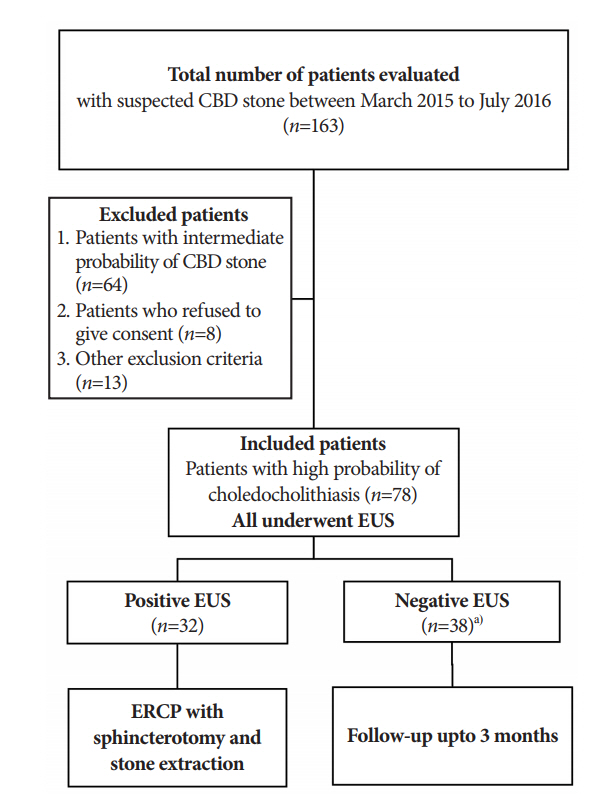Clin Endosc.
2017 Nov;50(6):592-597. 10.5946/ce.2017.010.
Endoscopic Ultrasonography Can Prevent Unnecessary Diagnostic Endoscopic Retrograde Cholangiopancreatography Even in Patients with High Likelihood of Choledocholithiasis and Inconclusive Ultrasonography: Results of a Prospective Study
- Affiliations
-
- 1Department of Gastroenterology, Lokmanya Tilak Municipal Medical College and Hospital, Mumbai, India. ruchir.cn@gmail.com
- KMID: 2398311
- DOI: http://doi.org/10.5946/ce.2017.010
Abstract
- BACKGROUND/AIMS
Endoscopic retrograde cholangiopancreatography (ERCP) is the initial therapy recommended for patients with high likelihood of choledocholithiasis. To determine whether endoscopic ultrasonography (EUS) can prevent diagnostic ERCPs in patients with high probability of choledocholithiasis and inconclusive ultrasonography (US).
METHODS
All patients with high likelihood of choledocholithiasis and negative US underwent EUS. ERCP was performed for the patients who showed a definite stone/sludge on EUS. Patients without choledocholithiasis were followed up for 3 months. The primary outcome was avoidance of diagnostic ERCP.
RESULTS
We included 78 patients (51 women; 27 men). Of these, 25 and 7 (total 41%) were diagnosed with choledocholithiasis and sludge, respectively; stone/sludge was removed in 96.9% of the patients. EUS ruled out choledocholithiasis in 38 patients (48.7%). Two of them were found to have choledocholithiasis on follow-up. The sensitivity, specificity, positive and negative predictive value of EUS for detecting choledocholithiasis were 93.9%, 97.3%, 96.9%, and 94.7%, respectively. Unnecessary ERCP was avoided in 57.7% of the patients by using the EUS-first approach.
CONCLUSIONS
EUS is a highly accurate and safe procedure. EUS can replace ERCP as the initial investigation in patients with a high probability of choledocholithiasis. It avoids unnecessary ERCP; hence, decreasing related costs and complications.
Keyword
MeSH Terms
Figure
Cited by 1 articles
-
Can Endoscopic Ultrasonography Prevent Unnecessary Endoscopic Retrograde Cholangiopancreatography in Patients with High and Intermediate Likelihood of Choledocholithiasis?
Eui Joo Kim, Jae Hee Cho
Clin Endosc. 2017;50(6):518-519. doi: 10.5946/ce.2017.158.
Reference
-
1. Collins C, Maguire D, Ireland A, Fitzgerald E, O’Sullivan GC. A prospective study of common bile duct calculi in patients undergoing laparoscopic cholecystectomy: natural history of choledocholithiasis revisited. Ann Surg. 2004; 239:28–33.2. Shiozawa S, Tsuchiya A, Kim DH, et al. Useful predictive factors of common bile duct stones prior to laparoscopic cholecystectomy for gallstones. Hepatogastroenterology. 2005; 52:1662–1665.3. Cohen ME, Slezak L, Wells CK, Andersen DK, Topazian M. Prediction of bile duct stones and complications in gallstone pancreatitis using early laboratory trends. Am J Gastroenterol. 2001; 96:3305–3311.
Article4. Polkowski M, Palucki J, Regula J, Tilszer A, Butruk E. Helical computed tomographic cholangiography versus endosonography for suspected bile duct stones: a prospective blinded study in non-jaundiced patients. Gut. 1999; 45:744–749.
Article5. Kohut M, Nowak A, Nowakowska-Dulawa E, Marek T, Kaczor R. Endosonography with linear array instead of endoscopic retrograde cholangiography as the diagnostic tool in patients with moderate suspicion of common bile duct stones. World J Gastroenterol. 2003; 9:612–614.
Article6. Buscarini E, Tansini P, Vallisa D, Zambelli A, Buscarini L. EUS for suspected choledocholithiasis: do benefits outweigh costs? A prospective, controlled study. Gastrointest Endosc. 2003; 57:510–518.
Article7. Canto MI, Chak A, Stellato T, Sivak MV Jr. Endoscopic ultrasonography versus cholangiography for the diagnosis of choledocholithiasis. Gastrointest Endosc. 1998; 47:439–448.
Article8. Tse F, Liu L, Barkun AN, Armstrong D, Moayyedi P. EUS: a meta-analysis of test performance in suspected choledocholithiasis. Gastrointest Endosc. 2008; 67:235–244.
Article9. Garrow D, Miller S, Sinha D, et al. Endoscopic ultrasound: a meta-analysis of test performance in suspected biliary obstruction. Clin Gastroenterol Hepatol. 2007; 5:616–623.
Article10. ASGE Standards of Practice Committee, Maple JT, Ben-Menachem T, et al. The role of endoscopy in the evaluation of suspected choledocholithiasis. Gastrointest Endosc. 2010; 71:1–9.
Article11. Prachayakul V, Aswakul P, Bhunthumkomol P, Deesomsak M. Diagnostic yield of endoscopic ultrasonography in patients with intermediate or high likelihood of choledocholithiasis: a retrospective study from one university-based endoscopy center. BMC Gastroenterol. 2014; 14:165.
Article12. De Lisi S, Leandro G, Buscarini E. Endoscopic ultrasonography versus endoscopic retrograde cholangiopancreatography in acute biliary pancreatitis: a systematic review. Eur J Gastroenterol Hepatol. 2011; 23:367–374.13. Anderloni A, Ballarè M, Pagliarulo M, et al. Prospective evaluation of early endoscopic ultrasonography for triage in suspected choledocholithiasis: results from a large single centre series. Dig Liver Dis. 2014; 46:335–339.
Article14. Tse F, Barkun JS, Barkun AN. The elective evaluation of patients with suspected choledocholithiasis undergoing laparoscopic cholecystectomy. Gastrointest Endosc. 2004; 60:437–448.
Article15. Kim KH, Kim W, Lee HI, Sung CK. Prediction of common bile duct stones: its validation in laparoscopic cholecystectomy. Hepatogastroenterology. 1997; 44:1574–1579.16. Zidi SH, Prat F, Le Guen O, et al. Use of magnetic resonance cholangiography in the diagnosis of choledocholithiasis: prospective comparison with a reference imaging method. Gut. 1999; 44:118–122.
Article17. Boraschi P, Neri E, Braccini G, et al. Choledocolithiasis: diagnostic accuracy of MR cholangiopancreatography. Three-year experience. Magn Reson Imaging. 1999; 17:1245–1253.
Article18. Lee YT, Chan FK, Leung WK, et al. Comparison of EUS and ERCP in the investigation with suspected biliary obstruction caused by choledocholithiasis: a randomized study. Gastrointest Endosc. 2008; 67:660–668.
Article19. Karakan T, Cindoruk M, Alagozlu H, Ergun M, Dumlu S, Unal S. EUS versus endoscopic retrograde cholangiography for patients with intermediate probability of bile duct stones: a prospective randomized trial. Gastrointest Endosc. 2009; 69:244–252.
Article20. Benjaminov F, Stein A, Lichtman G, Pomeranz I, Konikoff FM. Consecutive versus separate sessions of endoscopic ultrasound (EUS) and endoscopic retrograde cholangiopancreatography (ERCP) for symptomatic choledocholithiasis. Surg Endosc. 2013; 27:2117–2121.
Article21. Arguedas MR, Dupont AW, Wilcox CM. Where do ERCP, endoscopic ultrasound, magnetic resonance cholangiopancreatography, and intraoperative cholangiography fit in the management of acute biliary pancreatitis? A decision analysis model. Am J Gastroenterol. 2001; 96:2892–2899.
Article
- Full Text Links
- Actions
-
Cited
- CITED
-
- Close
- Share
- Similar articles
-
- Can Endoscopic Ultrasonography Prevent Unnecessary Endoscopic Retrograde Cholangiopancreatography in Patients with High and Intermediate Likelihood of Choledocholithiasis?
- Prospective controlled study of endoscopic ultrasonography and endoscopic retrograde cholangiography in patients with suspected choledocholithiasis
- Biliary Tract & Pancreas; Effectiveness of Endoscopic Ultrasonography in Detecting the Extrahepatic Choledocholithiasis
- Sensitivity and Specificity of Magnetic Resonance Cholangiopancreatography versus Endoscopic Ultrasonography against Endoscopic Retrograde Cholangiopancreatography in Diagnosing Choledocholithiasis: The Indonesian Experience
- The Efficacy of Endoscopic Ultrasonography for Diagnosing Common Bile Duct Stone


